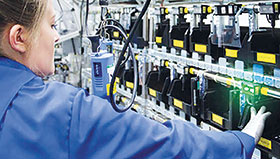

At parts assembly production sites, where parts are picked from stock, it is almost inevitable that picking mistakes will occur. As parts become more complex and their component types increase, the problem of picking mistakes grows. With Mitsubishi Electric’s Guided Operator Solutions, such mistakes can be eliminated, helping to reduce waste, improve quality and boost productivity.
Poka Yoke
Poka Yoke is the Japanese term used for mistake prevention. Statistically, it has been found that human error when picking parts is one of the most significant causes of mistakes in assembly operations. Typical problems include picking the wrong parts with a similar shape or name, picking and assembling parts out of sequence, or simply missing a part from a sequence.
While product inspection can prevent faulty goods being shipped to customers, it does little to prevent those defects from being introduced into the product in the first place. While for some companies a certain level of waste or rework will be accepted, for others there will be the desire to eliminate mistakes earlier in the production process before real value has been added to the product. To solve these issues, Mitsubishi Electric developed its integrated Guided Operator Solutions, based on the principles of Poka Yoke.
Tangible benefits
The costly impact of quality issues is largely recognised for manufacturing companies that engage in assembly tasks. Mitsubishi Electric’s Guided Operator Solutions not only significantly reduce the risk of these quality issues occurring, but they also can be deployed in a diverse range of industry sectors where the benefits can be identified by both managers and operators.
In a typical application, where personnel are required to pick a number of different parts or products from bins in sequence, the chances of the worker correctly picking the parts with 100% reliability every time are small. In the worst case, a mistake introduced into the product will go unnoticed until further up the production line – if at all.
However, with Guided Operator Solutions in place, the automation system guides the worker to the correct parts bin, perhaps by simply lighting an indicator next to the correct picking location, or by opening a shutter and requiring an operator acknowledgement of the successful pick of the correct part. Picking becomes not only inherently more reliable, but also faster, so both quality and overall productivity improve.
Totally integrated solution
Often assembly tasks must fit into the wider operational environment of the plant. This is essential to avoid the issues of over and under production. It is also important to consider the resource planning for parts used in the picking operations.
To permit connectivity to multiple picking applications within the plant, dedicated bridges connect stations over CC-Link and CC-Link IE networks. High-speed data communication enables synchronisation of tasks, but also allows assembly cells to be distributed according to the needs of the production site. Furthermore, direct integration of MES technology permits the Guided Operator Solutions to be connected to high level organisational systems so that output and resource planning are controlled in real time.
Guided Operator Solutions, sometimes known as pick to light solutions, were originally deployed for the automotive sector. However, with Mitsubishi Electric’s wide array of ergonomically designed terminals it is possible to deploy these solutions in many other industry areas that include logistics, semiconductor and life science sectors, which rely on processes such as parts replenishment, production cell picking and kitting for subsequent manufacture.
For more information contact Adroit Technologies, +27 (0)11 658 8100, [email protected], www.adroit.co.za
| Tel: | +27 11 658 8100 |
| Email: | [email protected] |
| www: | www.adroitscada.com |
| Articles: | More information and articles about Adroit Technologies |

© Technews Publishing (Pty) Ltd | All Rights Reserved